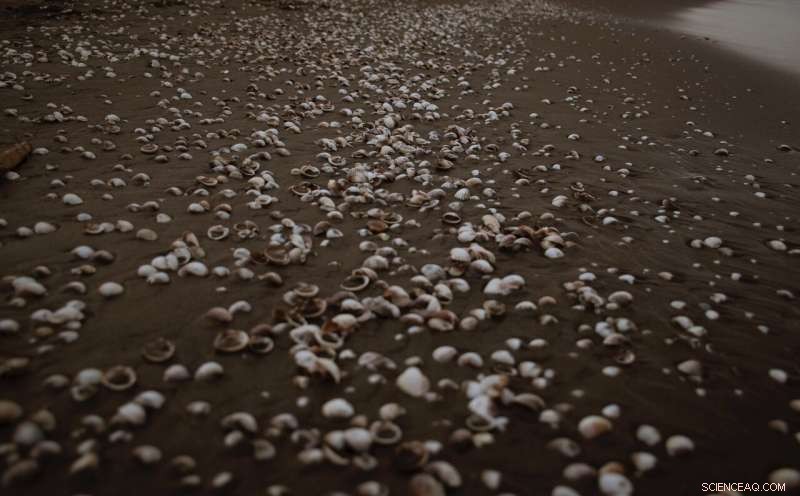
Wetenschap
Oesterschelpen worden voor topprijzen verkocht terwijl biologen zich inspannen om schelpdierbanken te beschermen

Tegoed:Unsplash/CC0 Publiek domein
Zittend op het kraaiennest van een kleine schuit, schermde de bootkapitein zijn ogen af van de julizon en richtte zijn blik op de commotie beneden.
Het gezoem van zwaar materieel en het gekletter van oesterschelpen verbrak de ochtendstilte toen werkploegen duizenden kilo's gedroogde schelpen op het dek stapelden en uiteindelijk een heuvel van 12 voet hoog creëerden.
Toen de laatste schelp op de stapel was geplaatst, manoeuvreerde de kapitein het schip weg van Russ Point Landing en een getijdenkreek af bij Fripp Island op een missie om wilde oesters te redden.
Het door de staat gesponsorde werk maakte deel uit van een poging om bedreigde oesterpopulaties te beschermen door schelpen van restaurants, oesterbraadstukken in de achtertuin en andere bronnen terug te brengen naar getijdengebieden. Door schelpen terug in de modder te plaatsen, worden riffen weer opgebouwd, de schuilplaatsen die babyoesters nodig hebben om te groeien en zich te vermenigvuldigen.
Maar pogingen om oesterriffen te herstellen in plaatsen zoals Beaufort County worden geconfronteerd met een bedreiging die vrijwel iedereen kan treffen die afhankelijk is van de oogst van wilde oesters.
South Carolina en nabijgelegen staten hebben moeite met het vinden van de schelpen die ze nodig hebben om terug te zetten in getijdengebieden om de oesterpopulaties te herstellen.
Ooit beschouwd als zeeafval, zijn oesterschelpen een waardevolle, maar beperkte handelswaar geworden langs de Zuid-Atlantische kust.
"Dit is absoluut een nationaal probleem met meerdere staten:het vinden van schelpen", zegt Ben Dyar, een oesterspecialist bij het South Carolina Department of Natural Resources.
Zonder voldoende aanvoer van schelpen zou de oesterpopulatie kunnen lijden, waardoor de commerciële oogst zou worden beperkt en de prijs van schelpdieren in restaurants zou stijgen. Minder oesterriffen en lagere populaties kunnen ook leiden tot meer vervuilde waterwegen, omdat oesters verontreinigingen in het water uitfilteren.
Er zijn meerdere redenen voor het tekort aan schelpen, waaronder de tol die de overmatige oogst door de jaren heen heeft geëist in Zuid-Atlantische staten. Maar mensen gooien de schelpen ook weg nadat ze oesters hebben geserveerd in visrestaurants of bij gemeenschappelijke oesterbraadstukken. Mensen gebruiken schelpen om opritten te plaveien en tuinen te verfraaien. En ze verpletteren schelpen om te verkopen voor kippenvoer of als ingrediënten in cosmetische producten.
Het tekort is zo groot dat sommige staten in de loop der jaren miljoenen dollars hebben uitgegeven om schelpen te kopen om oesterriffen te herstellen en weer op te bouwen - soms strijdend om de beperkte schelpen die worden aangeboden door huizen van Texas tot Virginia te pellen.
De prijzen zijn gestegen van ruim onder een dollar per schepel twee decennia geleden tot vele malen meer dan nu. De kosten lopen nu op van $ 3 tot $ 7 per schepel, zeggen sommige huiseigenaren en natuurbeambten van de staat.
South Carolina, met uitgestrekte moerassen en honderden visrestaurants, besteedt volgens het South Carolina Department of Natural Resources gemiddeld ongeveer $ 100.000 per jaar aan het kopen van schelpen uit andere staten.
Alles bij elkaar heeft de staat, gebruikmakend van verschillende financieringsbronnen, sinds 2012 bijna $ 1 miljoen uitgegeven om meer dan 407.000 bushels oesterschelpen te verwerven, wat overeenkomt met ongeveer 22 miljoen pond, volgens de DNR.
South Carolina betaalde minder dan $ 3 per bushel, maar de gemiddelde prijs is de afgelopen twee jaar boven $ 3 gestegen, zegt de DNR.
Concurrerende markt
Tal van andere staten hebben ook honger naar oesterschelpen.
Georgië besteedt jaarlijks ongeveer $ 138.000 om granaten te kopen en deze naar de Peach State te vervoeren. Schelpen komen vaak uit Florida en soms uit Texas.
Enkele van de grootste uitgaven aan de Zuid-Atlantische kust zijn rond de Chesapeake Bay in Maryland en Virginia.
Virginia besteedt jaarlijks $ 2 miljoen tot $ 3 miljoen aan het kopen van oesterschelpen van instate schilhuizen en andere bronnen in de staat, zeiden staatsfunctionarissen daar.
Maryland heeft zelfs treinwagons van gefossiliseerde oesterschelpen uit Florida gekocht om te helpen met haar oesterherstelprogramma's in de Chesapeake Bay, waar de oesterpopulaties zijn gedaald tot historische niveaus.
"Het is allemaal te gek", zegt Ted Wilgis, een oesterrifspecialist bij de non-profit North Carolina Coastal Federation. "Het werd gewoon een biedoorlog."
Sommige staten, waaronder South Carolina, zijn de laatste tijd succesvoller in het kopen van schelpen dan North Carolina, omdat de staat Tar Heel een limiet heeft voor hoeveel het kan uitgeven. In Georgië zeggen ambtenaren dat het niet altijd gemakkelijk is om oesters te vinden wanneer ze ze willen kopen.
"Oesterschelpen zijn een kostbaar goed geworden, met een vraag die het aanbod ver overtreft", zegt Cameron Brinton, een marien bioloog bij de Georgia's Coastal Resources Division.
Oesters, die in de meeste kustgebieden van de Verenigde Staten groeien, hebben een levenscyclus die afhangt van de getijden en hoe succesvol larvale oesters zijn in het vinden van harde oppervlakken.
Babyoesters, niet meer dan onduidelijke smurrie na het paaien, drijven op het getij en kleven aan harde oppervlakken, variërend van bestaande oesterriffen tot dokpalen of brugsteunen. In South Carolina, this process occurs during the spring and summer.
Once attached, they nestle into cracks and crevices, where they form their own shells and grow up.
But the best hard surfaces for baby oysters to stick to are existing oyster reefs, experts say.
'Shells are the profit'
Jeff Milliken's family has run oyster shucking businesses for more than 60 years in the coastal crossroads of Shallotte, North Carolina, selling canned oysters to grocery stores and restaurants.
Oyster sales always kept his family business afloat, providing a decent living for the Millikens.
But for years, oyster shells left over from the shucking process were little more than waste material. Piles of oyster shells at the shucking house were virtually given away.
That began to change in the 1980s, as people increasingly sought to buy the shells, Milliken said. And that has enriched his family business.
The company sometimes sells what it calls scoops of oyster shells, the amount that can be held in the bucket of a front-end loader, for about $500. In the 1980s, the charge was closer to $50, he said.
"My dad always made the point that the oysters pay the bills and the shells are the profit," Milliken, 60, said. "The shells have become very lucrative."
The South Carolina Department of Natural Resources buys large amounts of Milliken's shells to restore oyster beds.
"South Carolina has pretty much bought all of our production for reseeding the beds in South Carolina," Milliken said. "We do sell to the public but not like we used to. A lot of it is held for the state of South Carolina."
In addition to buying shells from people like Milliken, states are trying to re-use oyster shells, rather than letting them be dumped in landfills and in the woods, or crushed and used to pave driveways.
Commercial harvesters who lease oyster grounds from state agencies for private use often must put back a substantial percentage of oyster shells after they pluck shellfish from the mud.
Some states have launched oyster shell recycling programs that encourage restaurant owners to hold the shells until state natural resources officials or environmental groups can pick them up and replant them on public oyster grounds in the wild—as the South Carolina DNR did this summer near Fripp Island in Beaufort County.
State agencies and environmental groups from Maryland to Georgia have established shell drop-off sites on the coast for people who haul whole oysters home for backyard and community oyster roasts. State officials and volunteers then pick up shells at these drop-off sites and return them to marshes and sounds.
Additionally, some states have begun to allow oyster farming that could offset losses from wild populations.
Meanwhile, in North Carolina, Virginia and Maryland, resource managers are working to establish artificial reefs to offset the shortage of oyster shells and replenish wild shellfish populations near the Outer Banks and in the Chesapeake Bay.
For those reasons, oysters aren't likely to disappear from the landscape as a result of the shell shortage, many natural resources officials say. But losing wild oyster reefs could deplete the populations, they say. Even with some success from artificial oyster reefs, returning shells to the wild is generally considered the best way to replenish and enhance natural reefs, some experts say.
Some restaurant owners say it's vital to recycle oyster shells.
"If oysters are harvested but none of the shells are recycled," Hilton Head Island restaurateur and chef Chris Carge said, "the oyster seeds are just going to drift away" and eventually, the local oyster population will dwindle significantly.
Should oyster populations drop because there aren't enough shells to restore wild populations, it could diminish local fishing economies, drive up oyster prices for restaurants, hurt water quality and affect other marine species that thrive around oyster reefs, state officials say.
In South Carolina, for instance, more than 100 species of marine animals rely on oyster reefs for survival. These mounds of shells, which are submerged below the water at high tide, provide habitat for small bait fish, which then attract larger, popular sports fish, including red drum, sea trout and flounder, according to the state Department of Natural Resources.
Commercially caught oysters generate a dock value, or wholesale value, of some $3 million annually in South Carolina, making oysters the state's fourth-largest fishery, the DNR said in a report last winter.
Without an adequate supply of shells to replenish populations, oyster harvesting seasons might need to be shortened, a change sure to upset commercial and recreational fishermen.
"At some point, it is very plausible that there would have to be other measures and other tools taken to help manage that resource, meaning closing areas down for harvest for longer periods of time," Dyar said, noting it could have a corresponding effect on oyster prices.
Maintaining healthy oyster populations also is important because they filter out pollution in water, keeping tidal creeks cleaner.
Chicken feed and makeup
Perhaps the biggest reason for the lack of shells is historic over-harvesting in some areas, as well as the decline of shucking houses in others.
The Nature Conservancy found that 85% of the world's oyster reefs have been lost since the late 1800s because of over-harvesting, pollution and other factors, according to a South Carolina Sea Grant Consortium report.
Places like South Carolina also no longer have canneries where large supplies of oyster shells could be found to return to the salt marshes for restoration. At one point the state had 16 canneries, but the last one closed in 1986, according to the state DNR.
Some years, it is harder to find shells than in other years, depending on how many oysters are harvested. Beyond that, the lack of oyster shells may result, in part, from the public's increasing appetite for buying oysters in the shell, rather than in cans, and demand by a variety of businesses.
Poultry farms, construction companies and cosmetics manufacturers are among businesses that use oyster shells in their products. The calcium in oyster shells is believed to enhance many products, prompting efforts to find shells and grind them up.
Some poultry farmers purchase chicken feed supplements made from oyster shells. When fed to chickens, crushed oyster shells are believed to make egg shells harder.
Lesa Vold, a spokeswoman for the Egg Industry Center, said egg farmers like shell-based feed, but also are using other sources of calcium in places where shells are hard to find. The center supports egg producers across the country.
Milliken said his company for years sold crushed oyster shells to farm supply stores for sale to chicken farmers.
"We crushed just a huge amount of them," he said. "It's the best calcium for chicken egg-laying there is."
One marketing study, released this summer, said the oyster shell calcium market is expected to grow by 5% by 2030, fueled by an array of industrial demands for shells. Calcium carbonate in oyster shells is highly sought after, the study said.
The study, cited on the website Researchandmarkets.com, says oyster shell powder is useful in some skin-care products.
Worldwide, some manufacturers harvest oyster shells, crush them and blend them into facial cleansing powder, soaps and shampoo, according to a June 8 story on the website Premiumbeautynews.com.
Backyard oyster roasts
Another issue has arisen that has depleted the amount of oyster shells available to replenish wild populations.
Many shells are being scattered across the countryside, rather than returned to the salty tidelands of the southern Atlantic coast, after restaurants serve them or neighbors hold backyard oyster roasts.
Oysters harvested from the black pluff mud of Charleston may wind up sold to seafood markets whose customers are from Columbia, Greenville, Florence or Rock Hill. Those shells often are discarded in landfills or other places miles away from the coast.
"Quantities spread throughout the state (make) it a lot more difficult to capture that shell and bring it back to the coast," Dyar said in a report to the DNR board earlier this year.
It's difficult to say how many oysters have been removed from bays and creeks across the southeast and hauled inland, but natural resource managers say it's a problem, despite their best efforts.
South Carolina has one of the region's most robust shell recycling programs, with 30 sites where people can drop off shells after they've eaten oysters. Most of the sites are along the coast, although the DNR has them in Columbia and Greenville, as well. Once the shells are picked up, they are kept at multiple locations for months to dry out, which kills bacteria inside the shells.
But the state only captures about 12% of the shells that are harvested annually, meaning 88% of the shells from oysters sold in South Carolina are not recycled, according to a report by the S.C Department of Natural Resources.
Jean Fruh, executive director of The Outside Foundation, said the smell of keeping the oysters for typical once-a-week pickup, the cost, and additional training scare away some restaurant owners. However, the cost, Fruh and participating restaurateurs will tell you, is nominal:about $150 a month.
She said it's worth it.
"If you don't have oysters, you don't have fish, shrimp and crab," she said, because oysters create a critical habitat for the three during their juvenile period.
About 65 South Carolina restaurants collect shells for recycling, most of them in the Charleston area. Only a handful are in the Hilton Head Island and Myrtle Beach areas, according to the DNR.
Despite the struggle, natural resource managers in multiple states say they're still trying to maintain habitat for oysters, either through the use of artificial reefs, tighter laws on shell disposal, or recycling.
Dyar, the state DNR oyster specialist, said South Carolina's recycling program offers the best hope of maintaining enough oyster shells to replant in the marshes.
"We have seen over the last several years that sources are starting to become more scarce and the shells are becoming more expensive, causing an even more critical need for us to increase shell recycling within the state," Dyar said.
Oysters needed
During the July oyster planting trip, Michael Hodges, an oyster restoration biologist with the state DNR, directed the operation in the summer heat.
Hodges and his work partner, Kevin Swain, pushed the pile of oysters onto the barge with a front end loader. After the barge hauled its cargo to the destination point, a man aboard the barge fired a water cannon at the mound of shells, scattering them into the salt marsh at high tide.
It took only 20 minutes to lay the shells in about seven feet of water along a salt marsh bank. When the tide went out, the fruits of everyone's labor were obvious—a 390-yard line of human-planted oyster shells. It is expected to take about two years for a full row of mature oysters to develop.
Over the summer, the DNR set out to plant 10,000 bushels—or 550,000 pounds—of oyster shells in Beaufort waters, another 5,000 in Georgetown and 27,000 in Charleston.
Hodges said the program works—if the state has enough shells.
Without them, "we would see a decrease in the health of the oysters but also the health of the estuary, since they're so tied to habitat, water quality and all the ecosystem services that they provide," Hodges said. + Verder verkennen
A snappy solution to restoring oyster reefs
2022 The State.
Gedistribueerd door Tribune Content Agency, LLC.
 Titan-in-a-glass-experimenten duiden op minerale samenstelling van de Saturnusmaan
Titan-in-a-glass-experimenten duiden op minerale samenstelling van de Saturnusmaan Bacteriën aanvallen met op haaienhuid geïnspireerde oppervlakken
Bacteriën aanvallen met op haaienhuid geïnspireerde oppervlakken Uitleggen waarom condensatie exotherm is
Uitleggen waarom condensatie exotherm is  Q&A:Op weg naar een nieuwe manier om zonnecellen te produceren
Q&A:Op weg naar een nieuwe manier om zonnecellen te produceren Wat zijn de 3 meest voorkomende elementen in menselijke lichamen?
Wat zijn de 3 meest voorkomende elementen in menselijke lichamen?
 Reizen in steden koolstofarm maken met elektrische autonome taxi's
Reizen in steden koolstofarm maken met elektrische autonome taxi's Stedelijke hitte en koude eilandeffecten gecontroleerd door landbouw en irrigatie
Stedelijke hitte en koude eilandeffecten gecontroleerd door landbouw en irrigatie Nieuwe studie toont manieren om de temperatuurverlagende voordelen van groene daken in Chicago te maximaliseren
Nieuwe studie toont manieren om de temperatuurverlagende voordelen van groene daken in Chicago te maximaliseren Onderzoek onthult het klimaat van Kaapstad in het verleden
Onderzoek onthult het klimaat van Kaapstad in het verleden Gegevens van mobiele telefoons in combinatie met riooltesten tonen patronen in drugsgebruik
Gegevens van mobiele telefoons in combinatie met riooltesten tonen patronen in drugsgebruik
Hoofdlijnen
- Maleisië redt 140 schubdieren van vermoedelijke smokkelaars
- Sojavirus kan plantenvretende insecten een boost geven in overleving
- Duitsland zegt dat massale vissterfte in de rivier de Oder een door de mens veroorzaakte ramp is
- Plankton zwemt tegen de stroom in
- Onderzoek verduidelijkt de functie van de nucleaire hormoonreceptor in planten
- Ondanks de wet stijgt het aantal doden door loodvergiftiging in New Hampshire
- Als apen het bos als apotheek gebruiken
- Hoe bacteriën werken
- Waarom hebben we enzymen nodig voor de spijsvertering?
 5 Groene NASA-uitvindingen
5 Groene NASA-uitvindingen  Ruimtewandelende astronauten upgraden station met nieuwe batterijen
Ruimtewandelende astronauten upgraden station met nieuwe batterijen De nieuwe Star Wars zien? Wees voorzichtig met wat je wenst
De nieuwe Star Wars zien? Wees voorzichtig met wat je wenst Het volledige beeld van kinderarmoede begrijpen
Het volledige beeld van kinderarmoede begrijpen Wetenschappers onderzoeken de structuur van een sleutelgebied van telomerase-eiwit met een lange levensduur
Wetenschappers onderzoeken de structuur van een sleutelgebied van telomerase-eiwit met een lange levensduur Weer een dagje aan het werk, in het oog van een orkaan
Weer een dagje aan het werk, in het oog van een orkaan Amazon en Google gaan naar CES met digitale assistenten op sleeptouw
Amazon en Google gaan naar CES met digitale assistenten op sleeptouw Harde magneten met één molecuul:tetranucleaire zeldzame aardmetaalcomplexen met gigantische spin
Harde magneten met één molecuul:tetranucleaire zeldzame aardmetaalcomplexen met gigantische spin
- Elektronica
- Biologie
- Zonsverduistering
- Wiskunde
- French | Italian | Spanish | Portuguese | Swedish | German | Dutch | Danish | Norway |

-
Wetenschap © https://nl.scienceaq.com






